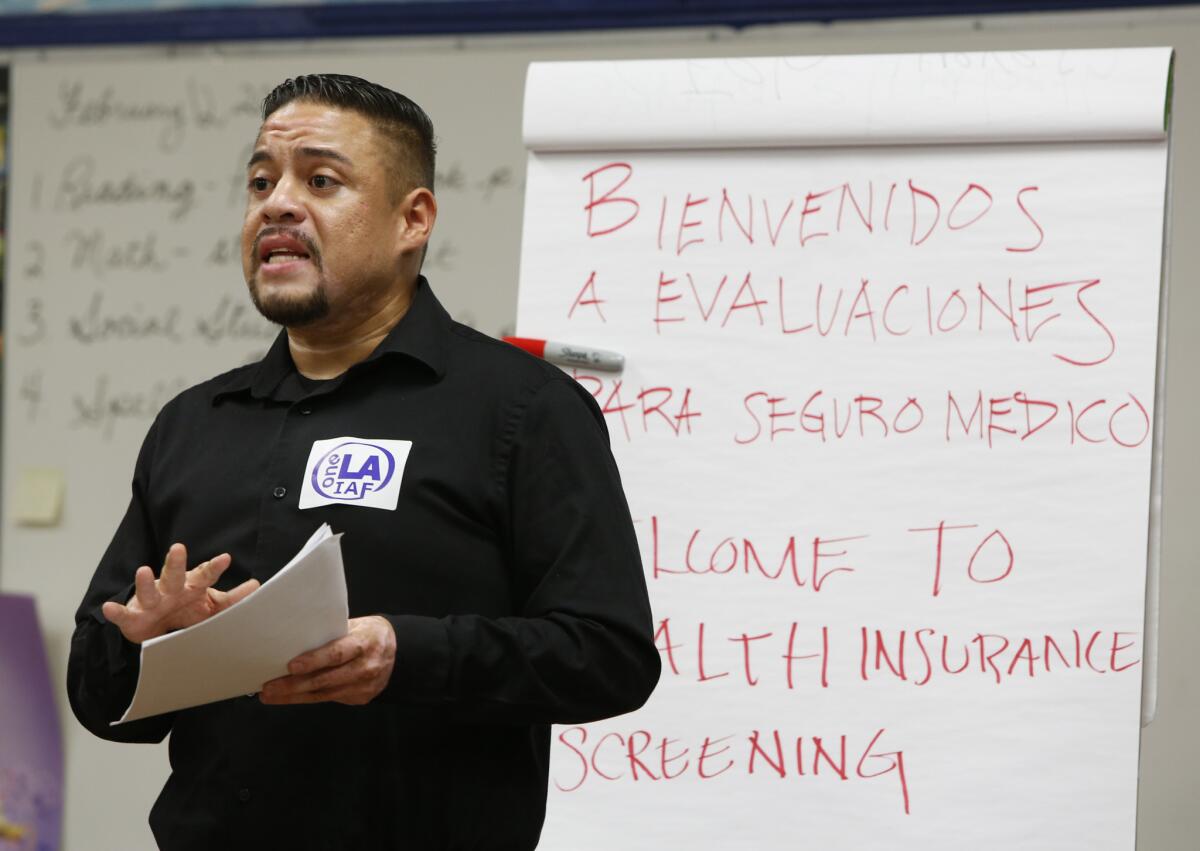Healthcare shocker: Medicaid is very good for kids

Organizer Edward Chavez of One LA speaks at a health screening event for enrollees in California’s Medicaid program, Medi-Cal, last year.
- Share via
Medicaid is the healthcare family’s poor relation. It’s taken for granted. Its quality is widely derided, even as it’s typically saddled with the lowest provider reimbursement rates of any government health program. Republican governors and legislatures refused to accept the central role it was given as the insurance plan for their poorest constituents (though that’s been changing).
So here’s a shocker: Children on Medicaid receive very good care — in many respects better than those on private insurance. That’s the conclusion of a survey of health data from 2003 to 2012 for 80,655 children, conducted by researchers at the University of Pennsylvania and Johns Hopkins. The children were in families earning between 100% and 300% of the federal poverty level — between $20,090 and $60,270 for a family of three in 2015.
Medicaid gets a really bad rap.
— Healthcare expert Harold Pollack
What this tells us, says healthcare policy expert Harold Pollack, is that “Medicaid gets a really bad rap.” There’s no dispute that it could be improved — but so could every other form of health insurance in America.
Before we look at the specific findings in the new report, let’s take a brief look at that bad rap. Among the most vociferous critics of the program is conservative commentator Avik Roy of the Manhattan Institute. Roy’s 2014 manifesto on replacing the Affordable Care Act charged Medicaid with having “the poorest health outcomes of any health insurance system in the industrialized world.” (He cited one of his own works as a source for this bold assertion.)
But Roy also acknowledged that to the extent there’s a problem with Medicaid, the “key reason” is that its reimbursement rates are so low — an estimated 58% of what they get from commercial insurers— that physicians are reluctant to take Medicaid patients on or to give them the same attention as other patients.
The solution should be obvious: Raise the reimbursement rates. This is something that conservatives like Roy are reluctant to do because it costs, you know, money. His solution is to convert Medicaid to a block grant to the states so that they could come up with innovative approaches to caring for the poor. That “could trigger a revolution in American health policy,” he says.
Perhaps, but the behavior of state governments gives scant reason for confidence, since 19 states, almost all under Republican control, still haven’t expanded Medicaid under the ACA to cover their needy citizens, even when the federal government would pay 100% of the costs through next year and no less than 90% afterward.
Medicaid remains the overlooked element of Obamacare — denigrated when it’s acknowledged at all. Pollack points to presidential aspirant Carly Fiorina’s remark at the Nov. 10 Republican debate that “Obamacare isn’t helping anyone. ... We’re throwing more and more people into Medicaid.”
But now comes the Penn/Hopkins study, which contradicts the received wisdom.
Of the children whose data were surveyed, more than 57% have private insurance, 13.6% had Medicaid, 18.4% were covered by the government’s Children’s Health Insurance Program, or CHIP (which is related to Medicaid), and 10.8% were uninsured.
The researchers found that children in Medicaid and CHIP were “significantly more likely” to receive preventive medical and dental care than those on private insurance — 88% vs. 83% on medical care and 80% vs. 73% for dental. For children with special medical needs, Medicaid consistently did better than private insurance: On 10 of 14 patient access and satisfaction measures, Medicaid outscored private insurers and ranked within a point or was tied on all the others.
On one category, Medicaid trounced the opposition: out-of-pocket costs. Only 26% of families reported facing those, against 77% in private insurance.
Pollack attributes much of a discrepancy to Medicaid’s history as a social insurance program, which gives it a better focus on issues that might arise within a low-income population. “Medicaid offers more comprehensive long-term disability services and supports than Medicare or private insurance,” he observes. “Medicaid has fewer hidden traps or unexpected out-of-pocket payments. ... State Medicaid programs also have decades of experience serving children and adults living with disabilities. Medicaid-funded providers often have pioneered integrated care models and the use of team care.
Indeed, he says, some Obamacare exchange health plans exclude pediatric development and mental health services that Medicaid provides. That’s an important consideration for state officials pursuing the option of trying to shift their Medicaid populations into private health plans under the mistaken notion that the change inevitably would save money and hold up as a “revolution” in policy.
Yes, Medicaid is underfunded, but its real problem may be that it’s identified as a service for low-income Americans, which saps it of political strength. There’s no question that it’s better than no insurance at all, and now there’s evidence that, in some respects, it may even be better than private insurance.
Keep up to date with the Economy Hub. Follow @hiltzikm on Twitter, see our Facebook page, or email michael.hiltzik@latimes.com.
MORE FROM MICHAEL HILTZIK
The squabble over Anne Frank’s diary shows the absurdity of copyright law
Pfizer’s creative merger plan revives concerns about tax-avoiding ‘inversions’
Why T-Mobile’s new ‘free’ data plan is bad for the Internet -- and worse for you
More to Read
Inside the business of entertainment
The Wide Shot brings you news, analysis and insights on everything from streaming wars to production — and what it all means for the future.
You may occasionally receive promotional content from the Los Angeles Times.











